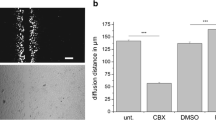Summary
Fluorescent dyes are commonly used to study permeable (gap) junctions, but only rarely have quantitative values for junctional dye permeability been determined. In the present study, junctional permeance (PA, i.e., the product of the junctional permeability coefficient,P, times the junctional area,A) to Lucifer Yellow CH (LY) has been obtained for pairs of Novikoff hepatoma cells. Dye was microinjected into one cell and the subsequent transfer monitored by a SIT camera and recorded on video tape. The intensities of fluorescence in the injected and “recipient” cell were measured using a Digisector (Microworks) digitizing board and an Apple II Plus computer to analyze the video records. These changes in intensity, along with an estimate of volume of the spherical cells, were used to calculate the junctional permeance (PA) of cell pairs according to Fick's diffusion equation. Junctional permeances show considerable variation ranging from 0.08×10−11 to 27.0×10−11 cm3/sec. Using the meanPA and a previous estimate of the mean number of junctional channels per interface in the Novikoff cultures, a value for diffusion coefficient of LY through gap junctions is calculated to be about 1.4×10−6 cm2/sec. There is a general proportionality between meanPA and cell volume for hepatoma cell pairs of a certain size range. Such a relationship between cell volume and junctional capacity suggests one source of variation ofPA. Other possible sources, e.g., related to position in the cell cycle, are discussed.
Similar content being viewed by others
References
Atkinson, M.M., Menko, A.S., Johnson, R.G., Sheppard, J.R., Sheridan, J.D. 1981. Rapid and reversible reduction of junctional permeability in cells infected with a temperature-sensitive mutant of avian sarcoma virus.J. Cell. Biol. 91:573–578
Atkinson, M.M., Sheridan, J.D. 1985. Reduced junctional permeability in cells transformed by different viral oncogenes.In. Gap Junctions. M.V.L. Bennett and D.C. Spray, editors. pp. 205–213. Cold Spring Harbor Laboratory, Cold Spring, N. Y.
Bennett, M.V.L., Spray, D.C. (editor) 1985. Gap Junctions. Cold Spring Harbor Laboratory, Cold Spring, N.Y.
Biegon, R.P., Atkinson, M.M., Sheridan, J.D. 1986. Comparison of two fluorescent dye transfer rates through gap junctions in Novikoff hepatoma cells.Biophys. J. 49:342a
Brink, P.R., Ramanan, S.V. 1985. A model for the diffusion of fluorescent probes in the septate giant axon of earthworm. Axoplasmic diffusion and junctional membrane permeability.Biophys. J. 48:299–309
Johnson, R. Hammer, M., Sheridan, J., Revel, J.P. 1974. Gap junction formation between reaggregated Novikoff hepatoma cells.Proc. Natl. Acad. Sci. USA 71:4536–4540
Johnson, R.G., Sheridan, J.D. 1971. Junctions between cancer cells in culture: Ultrastructure and permeability.Science 174:717–719
Liu, T.F., Kam, E.Y., Sheridan, J.D. 1982. Dye transfer through permeable junctions between cultured mammalian cells: Quantitative video analysis.J. Cell Biol. 95:106a
Loewenstein, W.R. 1981. Junctional intercellular communication: The cell-to-cell membrane channel.Physiol. Rev. 61:829–913
Pederson, D.C., Sheridan, J.D., Johnson, R.G. 1980. The development of metabolite transfer between reaggregating Novikoff hepatoma cells.Exp. Cell Res. 127:159–177
Peracchia, C. 1980. Structural correlates of gap junction permeation.Int. Rev. Cytol. 66:81–146
Plagemann, P.G.W., Swim, H.E. 1966. Replication of mengovirus: I. Effect on synthesis of macromolecules by host cell.J. Bacteriol. 91:2317–2326
Pollack, G.H. 1976. Intercellular coupling in the atrioventricular node and other tissues of the rabbit heart.J. Physiol. (London) 255:275–298
Preus, D., Johnson, R.G., Sheridan, J.D. 1981a. Gap junctions between Novikoff hepatoma cells following dissociation and recovery in the absence of cell contact.J. Ultrastruct. Res. 77:248–262
Preus, D., Johnson, R.G., Sheridan, J.D., Meyer, R. 1981b. Analysis of gap junctions and formation plaques between reaggregating Novikoff hepatoma cells.J. Ultrastruct. Res. 77:263–276
Safranyos, R.G.A., Cavaney, S. 1985. Rates of diffusion of fluorescent molecules via cell-to-cell membrane channels in a developing tissue.J. Cell Biol. 100:736–747
Schwarzmann, G., Wiegand, H., Rose, B., Zimmerman, A., Ben-Haim, D., Loewenstein, W.R. 1981. Diameter of the cell-to-cell junctional membrane channels as probed with neutral molecules.Science 213:551–553
Sheridan, J.D. 1973. Functional evaluation of low resistance junction: Influence of cell shape and size.Am. Zool. 13:1119–1128
Sheridan, J.D., Atkinson, M.M. 1985. Physiological roles of permeable junctions: Some possibilities.Annu. Rev. Physiol. 47:337–353
Sheridan, J.D., Hammer-Wilson, M., Preus, D., Johnson, R.G. 1978. Quantitative analysis of low resistance junctions between cultured cells and correlation with gap junctional areas.J. Cell Biol. 76:532–544
Simpson, I., Rose, B., Loewenstein, W.R. 1977. Size limit of molecules permeating the junctional membrane channels.Science 195:294–296
Socolar, S.J., Loewenstein, W.R. 1979. Methods for studying transmission through permeable cell-to-cell junctions.In: Methods in Membrane Biology. pp. 123–179. E. Korn, editor, Plenum, New York
Stewart, W.W. 1978. Functional connections between cells as revealed by dye-coupling with a highly fluorescent naphthalamid tracer.Cell 4:741–759
Zimmerman, A.L., Rose, B. 1985. Permeability properties of cell-to-cell channels: Kinetics of fluorescent tracer diffusion through a cell junction.J. Membrane Biol. 84:269–283
Author information
Authors and Affiliations
Rights and permissions
About this article
Cite this article
Biegon, R.P., Atkinson, M.M., Liu, TF. et al. Permeance of novikoff hepatoma gap junctions: Quantitative video analysis of dye transfer. J. Membrain Biol. 96, 225–233 (1987). https://doi.org/10.1007/BF01869304
Received:
Revised:
Issue Date:
DOI: https://doi.org/10.1007/BF01869304



